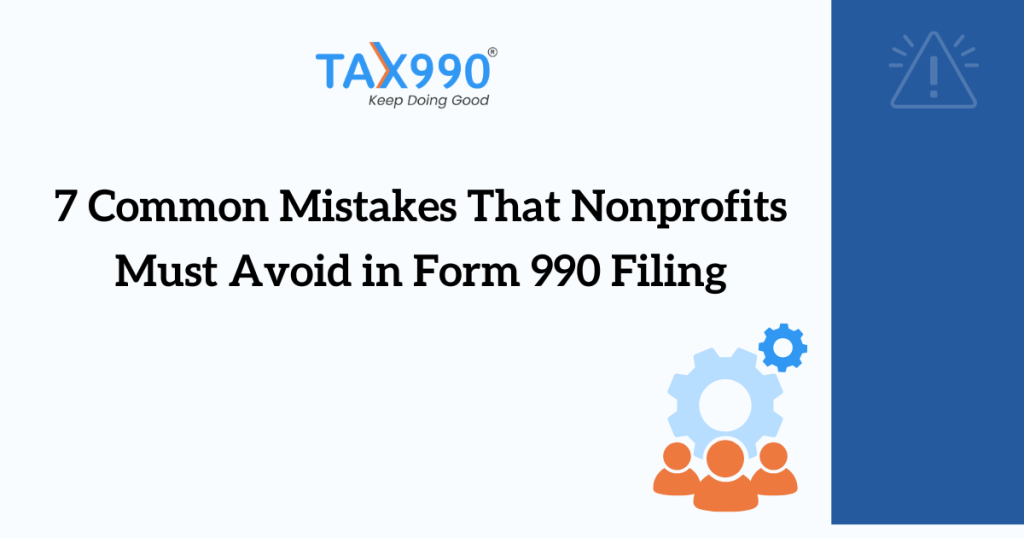7 Common Mistakes That Nonprofits Must Avoid in Form 990 Filing
Estimated reading time: 18 minute(s)

Form 990 is a big deal for nonprofits in the U.S. It’s how the IRS keeps track of your organization’s finances, activities, and overall compliance. But it’s more than just a tax form; it’s also public information that donors, grantmakers, and other stakeholders use to evaluate your nonprofit. That’s why accuracy matters. Errors in your 990 forms can lead to penalties, damage your reputation, and even put your tax-exempt status at risk. To prevent these, familiarize yourself with the most common errors nonprofits encounter on Form 990 and learn how to avoid them.
What are the Common Mistakes Nonprofits Should Avoid?
Managing tax compliance can be challenging for nonprofits, but understanding these mistakes can help you avoid penalties and safeguard your tax-exempt status. Here are five common pitfalls to avoid when filing your 990 returns.
1. Choosing Incorrect Form
Choosing the right version of Form 990 is crucial for your nonprofit. The IRS provides several forms based on your nonprofit’s financial status, and filing the wrong one can lead to delays and complications. The key forms are:
- Form 990-N: For nonprofits with gross receipts of $50,000 or less.
- Form 990-EZ: For nonprofits with gross receipts under $200,000 and assets under $500,000.
- Form 990: For nonprofits with gross receipts of $200,000 or more, or assets of $500,000 or more.
- Form 990-PF: For private foundations.
- Form 990-T: If your nonprofit has unrelated business income (UBI) of $1,000 or more.
Best Practice: Always verify your nonprofit’s financials to ensure you file the correct form. This will save time and prevent unnecessary complications in your filing. Which 990 form should I file?
2. Not Filing on Time
Filing Form 990 is crucial for maintaining your nonprofit’s tax-exempt status. The IRS deadline is the 15th day of the 5th month after the end of your accounting period. If your organization follows a calendar tax year, the deadline to file your 990 is May 15th. Failing to meet the deadline, especially for three consecutive years, will result in the automatic loss of tax-exempt status.
Best Practice: Set a reminder well in advance of the deadline, and if necessary, request an extension using Form 8868, which gives you an additional six months. However, remember that this extension doesn’t apply to payments due, so ensure you’re up-to-date on any tax obligations.
3. Filing a 990 for the Wrong Tax Year
Filing Form 990 for the correct tax year is essential for smooth processing. The IRS requires nonprofits to file Form 990 for the fiscal year that ends within the specified deadline. Mistakes in selecting the tax year can lead to rejection, delays, or complications in the filing process.
- Duplicate Filing Rejection: One common error occurs when an organization inadvertently attempts to file Form 990 for the same tax year more than once. The IRS will reject duplicate filings for the same year, causing delays in your submission and requiring additional steps to resolve.
- Short Tax Year Scenarios: If your organization is filing for a short tax year (less than 12 months), the process differs slightly. This can happen if your organization changed its fiscal year or was newly formed during the year. In these cases, you’ll need to file Form 990 for the short tax year, ensuring that the dates on the form accurately reflect the shortened period.
Best Practice: Double-check the tax year on the form before filing. If your organization is filing for a short tax year (less than 12 months), ensure that the correct tax year and dates are entered. In cases of duplicate filing, the IRS will reject your return, so always confirm that no prior submission has been made for the same tax year.
4. Not Keeping Proper Records
Accurate record-keeping is crucial for nonprofit compliance. Organizations must maintain detailed records of revenue, expenses, grants, executive compensation, and governance policies. Poor documentation can lead to incomplete or inaccurate reporting, increasing the risk of IRS audits and penalties.
Best Practice: Implement an organized record-keeping system throughout the year. Use accounting software to track income and expenses, and keep documentation of board meetings and grant distributions. This will not only simplify your filing but also ensure that you can quickly access all relevant documents in case of an IRS audit.
5. Skipping Governance and Compliance Sections
The governance and compliance sections of Form 990 provide transparency about a nonprofit’s leadership, policies, and operational oversight. Failing to report board members, key officers, and governance policies can raise red flags with the IRS and donors.
Best Practice: Ensure all governance details, such as board members and key officers, are accurately reported. Include relevant policies and internal controls that your organization follows. By doing this, you will maintain both transparency and compliance with IRS regulations.
6. Inaccurate Financial Reporting
Accurately reporting all financial information, including income, expenses, and assets, is important when filing your 990 return. Poor record-keeping can lead to errors, delays, and compliance issues.
Best Practice: Ensure your financial data is organized, and cross-check all figures before submission. Use software designed for nonprofit financials or work with an accountant to ensure the accuracy of the numbers reported. Proper documentation of executive compensation, revenue sources, and grant distributions is critical to accurate financial reporting.
7. Organizations Not Recognized as Tax-Exempt
Nonprofits must have IRS-approved tax-exempt status to file Form 990. Filing without approval may cause errors or rejection. If your organization has applied but not received approval, select ‘Application Pending’ when submitting Form 990. Additionally, the IRS may have revoked your status if you haven’t filed the required Form 990 return for three years. In this case, you must reinstate it.
Best Practice: Before filing, verify your organization’s status with the IRS. If you are in the process of applying for tax-exempt status or if your status has been revoked, ensure that you’re following the proper steps for reinstatement. Always check the status before proceeding with Form 990 to prevent issues.
Conclusion
Correctly filing Form 990 is crucial for maintaining your nonprofit’s tax-exempt status and credibility. You can avoid penalties and IRS scrutiny by avoiding common mistakes—such as misclassifying your tax-exempt status, failing to file on time, or providing inaccurate financial reports. By following best practices, your organization can ensure a smooth and compliant filing process.
Tax990 simplifies the Form 990 filing experience, making it seamless, accurate, and time-saving for nonprofit organizations and tax professionals. With its extensive features, you can file with ease.




Leave a Comment